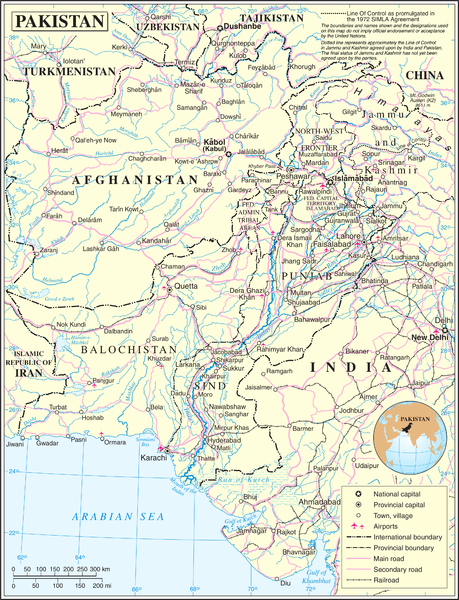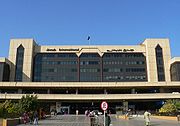
Rail
 a
a


Domestic
Rail services in Pakistan are provided by the state-run Pakistan Railways, under the supervision of the Ministry of Railways. Pakistan Railways provides an important mode of transportation in Pakistan, catering to the large-scale movement of people and freight. The railway network comprises 8,163 km[1] of which 1,676 mm (5 ft 6 in) (broad gauge) forms 7,718 km including 293 km of electrified track. Template:Rail Gauge narrow gauge tracks form the remaining 445 km. Passenger earnings comprise of 50% of the total revenue. During 1999-2000 this amounted to Rs. 4.8 billion.[citation needed] Pakistan Railways carry 65 million passengers annually and daily operates 228 mail, express and passenger trains.[citation needed] Pakistan Railways also operate special trains for various occasions. The Freight Business Unit with 12000 personnel operates over 200 freight stations on the railway network. The FBU serves the Port of Karachi and Port Qasim as well as in various other stations along the network and generates revenue from the movement of agricultural, industrial and imported products such as wheat, coal, fertilizer, cement, and sugar. About 39% of the revenue is generated from the transportation of petroleum, 19% from imported wheat, fertilizer and rock phosphate. The remaining 42% is earned from domestic traffic.[citation needed] The freight rates structure is based on market trends in road transport which is the main competitor to rail transport.
Mass Transit
The Karachi Circular Railway, which opened in the early 1940s, is the only functioning Mass Transit System in Pakistan as of date. In 1976, Karachi was slated to begin work on an underground metro system, but plans have been put on hold since. The Lahore Metro is another proposal still in planning and is scheduled to be completed by 2020.
International
![]() Iran - A broad gauge railway line runs from Zahedan to Quetta, and a standard gauge line is finished from Zahedan to Kerman in central Iran, linking with the rest of the Iranian rail network. On May 18, 2007, a MOU for rail cooperation was signed by Pakistan and Iran under which the line will be completed by December 2008. Now that the rail systems are linked up at Zahedan, there is a break-of-gauge between the Islamic Republic of Iran Railways standard gauge tracks and Pakistan Railways broad gauge.[2]
Iran - A broad gauge railway line runs from Zahedan to Quetta, and a standard gauge line is finished from Zahedan to Kerman in central Iran, linking with the rest of the Iranian rail network. On May 18, 2007, a MOU for rail cooperation was signed by Pakistan and Iran under which the line will be completed by December 2008. Now that the rail systems are linked up at Zahedan, there is a break-of-gauge between the Islamic Republic of Iran Railways standard gauge tracks and Pakistan Railways broad gauge.[2]
![]() Afghanistan - Currently there is no rail link to Afghanistan since no railway network is present in that country, however Pakistan Rail has proposed to help build a Afghani Rail Network in three phases. The first phase will stretch from the Chaman to Spin Boldak in Afghanistan. The second phase will extend line to Kandahar and the third phase will eventually connect to Herat. From there, the line will be extended to Khushka, Turkmenistan. The final phase would link 1,676 mm (5 ft 6 in) gauge with Central Asian 1,520 mm (4 ft 117⁄8 in) gauge. It is not clear where the break-of-gauge station will be.[3] The proposed line will also be connected the port town of Gwadar via Dalbadin and Taftan, thus connecting the port town to Central Asia.
Afghanistan - Currently there is no rail link to Afghanistan since no railway network is present in that country, however Pakistan Rail has proposed to help build a Afghani Rail Network in three phases. The first phase will stretch from the Chaman to Spin Boldak in Afghanistan. The second phase will extend line to Kandahar and the third phase will eventually connect to Herat. From there, the line will be extended to Khushka, Turkmenistan. The final phase would link 1,676 mm (5 ft 6 in) gauge with Central Asian 1,520 mm (4 ft 117⁄8 in) gauge. It is not clear where the break-of-gauge station will be.[3] The proposed line will also be connected the port town of Gwadar via Dalbadin and Taftan, thus connecting the port town to Central Asia.
![]() China - There is no link with China however, on February 28, 2007 contracts were awarded for feasibility studies on a proposed line from Havelian via the Khunjerab pass at 4730 m above sea level, to the Chinese railhead at Kashgar, a distance of about 750 km.[4]
China - There is no link with China however, on February 28, 2007 contracts were awarded for feasibility studies on a proposed line from Havelian via the Khunjerab pass at 4730 m above sea level, to the Chinese railhead at Kashgar, a distance of about 750 km.[4]
![]() Turkey - A proposed Istanbul-Tehran-Islamabad passenger rail service was proposed recently. . Meanwhile a container train service was launched by the Prime Minister of Pakistan Yousuf Raza Gilani between Islamabad and Istanbul on 14 August 2009. The first train carried 20 containers with a capacity of around 750 t (738 LT; 827 ST) and will travel 6,500 km (4,000 mi) from Islamabad, through Tehran, Iran and on to Istanbul in two weeks' time.[7] According to the Minister for Railways Ghulam Ahmad Bilour, after the trial of the container train service, a passenger train will be launched. There are also hopes the route will eventually provide a link to Europe and Central Asia, and carry passengers.
Turkey - A proposed Istanbul-Tehran-Islamabad passenger rail service was proposed recently. . Meanwhile a container train service was launched by the Prime Minister of Pakistan Yousuf Raza Gilani between Islamabad and Istanbul on 14 August 2009. The first train carried 20 containers with a capacity of around 750 t (738 LT; 827 ST) and will travel 6,500 km (4,000 mi) from Islamabad, through Tehran, Iran and on to Istanbul in two weeks' time.[7] According to the Minister for Railways Ghulam Ahmad Bilour, after the trial of the container train service, a passenger train will be launched. There are also hopes the route will eventually provide a link to Europe and Central Asia, and carry passengers.
![]() Turkmenistan - via Afghanistan Road
Turkmenistan - via Afghanistan Road




National Highways
During the 1990s, Pakistan began an ongoing project to rebuild all national highways throughout the country specifically to important financial, cargo and textile centers. The National Highway Authority or NHA is responsible for the maintenance of all national highways in Pakistan.
- The Makran Coastal Highway follows the coast of Sindh and Balochistan provinces, linking Karachi and Gwadar. Journey time has been reduced to six or seven hours with the construction of the new Coastal Highway. The highway was built as part of an overall plan to improve transport facilities in southern Balochistan.
- The Karakoram Highway is the highest paved international road in the world. It connects China and Pakistan across the Karakoram mountain range, through the Khunjerab Pass.
- The Grand Trunk Road (commonly abbreviated to GT Road) is one of South Asia's oldest and longest major roads. For several centuries, it has linked the eastern and western regions of the South Asia, running from Bengal, across north India, into Peshawar in Pakistan.
- The Silk Road is an extensive interconnected network of trade routes across the Asian continent connecting East, South, and Western Asia with the Mediterranean world, including North Africa and Europe. It passes through the mid section of Pakistan through cities: Peshawar, Taxila and Multan.
Motorways
The construction of motorways began in the early 1990s with the idea building a world class road network and to reduce the load off the heavily used national highways throughout the country. The M2 was the first motorway completed in 1998, linking the cities of Islamabad and Lahore. In the past 5 years, many new motorways have opened up including the M1, M3.
- Total: 257,683 km
- Paved: 152,033 km (including 339 km of expressways)
- Unpaved: 105,650 km (2001)
- Vehicles on road: 4.2 million vehicles 250,000 commercial vehicles (2004 estimate)
Waterways

The waterway network in Pakistan is in its infancy with Karachi being the only major city situated next to the Arabian Sea. Still plans are being proposed for the development of the waterways in the country along the Indus River and through the Punjab as it would boost employment opportunities and the economic and social development of Pakistan.
- Port of Gwadar - Gwadar, Balochistan
- Port of Karachi - Karachi City Center
- Port Qasim - East Karachi
- Port of Pasni - Pasni, Balochistan
Air transport


Pakistan has 139 airports. The main airport include:
- Jinnah International Airport (Karachi)
- Allama Iqbal International Airport (Lahore)
- Benazir Bhutto International Airport (Islamabad)
- Peshawar International Airport
- Quetta International Airport
- Faisalabad International Airport
- Multan International Airport
- Sialkot International Airport
- Gwadar International Airport
There are also several smaller airports which have flights to and from the Gulf because of the large Pakistani diaspora working in the region. There are 91 airports with paved runways of which 14 have runways longer than 3,047 meters. The remaining 48 airports have unpaved runways including one airport with a runway longer than 3,047 meters. Pakistan also has eighteen heliports.
Local Transport



In urban areas there are several means of transport available, catering to a wide range of budgets.
Buses
- Domestic
Within cities, buses provide a significant role in commuting a large population from one point in a city to another. There are two main owners that are able to run bus services: government or private. The Flying Coach are private run yellow and white vans that run services throughout the city to get commuters from one point in the city to the other. These are also referred to as "mini-buses" as the are smaller versions of the coaches that carry less people and get commuters to their destinations more quickly.
Since 2000, the government has taken a comprehensive initiative to modernize the existing bus fleets and minimally impact the environment. This public-private enterprise would gradually introduce 8,000 CNG buses throughout the country and 800 buses in Karachi. This venture will ensure high standards of efficiency and cleanliness[10].
- Inter City
Bus service in urban areas and between cities is well established with services run by both public and private sectors. Bus services like Daewoo Express, Kohistan, Skyway and Niazi Bus have set up modern intercity service in Pakistan which connects to most cities in Pakistan and runs 24 hours a day. Intercity buses tend to be more modern and well kept as compared to urban transport within cities which are also well established, however the fleet of buses used tend to be in horrible shape and are not air-conditioned.
- International
International bus services are also well established in Pakistan and connect to various countries:
- Quetta - Zahidan, Iran
- Quetta - Mashad, Iran
- Gwadar - Zahidan, Iran (2010)
- Karachi - Quetta - Zahidan - Tehran, Iran (proposed)
- Peshawar - Jalalabad, Afghanistan
- Peshawar - Kabul, Afghanistan
- Islamabad - Dushanbe, Uzbekistan
- Islamabad - Kashghar, China
- Lahore - Delhi, India
[edit] Auto Rickshaws


Auto rickshaws are a popular method of traveling in cities and are found in almost every city and town in Pakistan. The fare is usually negotiable before commencing a journey, however due to the level of pollution contributed by the auto-rickshaws, the government has recently begun banning older auto richshaws and replacing them with CNG auto rickshaws, which tend to be less noisy, forms less pollutants and are much bigger and more comfortable than the older sets of richshaws. The Punjab Government decided in 2005 to replace two-stroke three-wheelers with CNG-fitted four-stroke rickshaws in Lahore, Multan, Faisalabad, Rawalpindi and Gujranwala. Three manufacturers were ordered to produce 60,000 four-stroke vehicles, but they reportedly supplied 2,000 to the government which were now plying on city roads. Similar ordinances are now being considered in other provinces of Pakistan. A new form of transport in Pakistan is the Qing-Qi (pronounced "ching-chee"), which is a cross between a motorcycle and auto-rickshaw. It runs just like a motorcycle but comes with three wheels instead of two and carries a much heavier load on its back. It is an urban transport vehicle and is used mostly for short distances.
Taxis
Another very common sight seen mainly at hotels and airports are yellow taxis. The drivers charge according to a meter located on the dashboard of the car, but fares can be negotiated if there is no meter. The cab drivers are reliable and will take passengers to any destination required. There are also numerous privately run services that use cars and minibuses of various types throughout Pakistan, providing a reliable and quick means of transport. Recently, the Radio Cab was introduced in Pakistan, which offers riders to call a toll free number to get in touch with the closes taxi stand. This service is currently offered in Islamabad, Rawalpindi, Karachi, Peshawar and Lahore. Services for Hyderabad and Sialkot are now being made.
Cars
Over the years, the number of cars on Pakistani roads has tripled. Traffic jams are a common scene in major cities across Pakistan. The most popular cars on Pakistani roads are, Suzuki Mehran, Suzuki khyber, Suzuki Alto, Suzuki Cultus, Daihatsu Coure, Hyundai Santro, Honda Civic, Honda City, Honda Accord, Toyota Corolla and Toyota Vitz. In late 2005, Suzuki introduced the APV (All-Purpose Vehicle) the first luxury family van in Pakistan. Utility vehicles (SUVs or 4x4s) are also a familiar sight in Pakistan. This type of car is very multi functional as it allows long distance and off road travel, within cities as well as city to city travel. The most popular models are the Toyota Land Cruiser, Toyota Prado, Mitsubishi Pajero, Kia Sportage, Suzuki APV can also be sighted. Adam Revo, Pakistan's first manufactured car, was developed to meet the needs of low income families.
Traditional

In the small towns and farms, many people decide to walk great distances to either get to work or to walk to their nearest grocery store to get their daily shopping. The donkey and cart, locally known as the Reyri, is still visible every where in Pakistan, as people are poor they use this form of transport to shift cargo from one part of a city to the next. The cargo they hold ranges from fruits and vegetables, textiles or machinery that factories require in industrial cities. The House & Carriage, locally known as Tangahs are mainly seen used for casual travelling around the city. There is one driver, with either one or two horses at the front. This method is now usually used by tourists in the spring and summer that love to see the cities in an open environment. Camel & Cart are also seen from time to time. Mostly seen in the hotter parts of Pakistan including Sindh, Punjab and Balochistan where farmers transport larger cargo that donkey carts can not handle. Bicycles are used by either the poorer society or for leisure. This method is still very widely used as its very economical and simple to run.





No comments:
Post a Comment